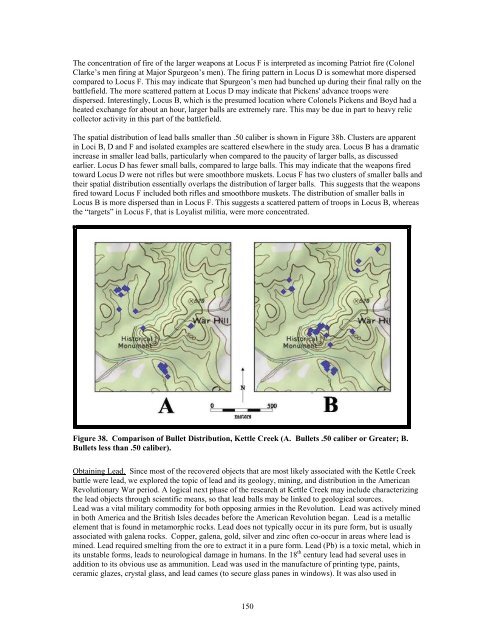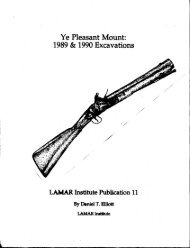Stirring Up a Hornet's Nest: - UGA Laboratory of Archaeology ...
Stirring Up a Hornet's Nest: - UGA Laboratory of Archaeology ...
Stirring Up a Hornet's Nest: - UGA Laboratory of Archaeology ...
Create successful ePaper yourself
Turn your PDF publications into a flip-book with our unique Google optimized e-Paper software.
The concentration <strong>of</strong> fire <strong>of</strong> the larger weapons at Locus F is interpreted as incoming Patriot fire (Colonel<br />
Clarke’s men firing at Major Spurgeon’s men). The firing pattern in Locus D is somewhat more dispersed<br />
compared to Locus F. This may indicate that Spurgeon’s men had bunched up during their final rally on the<br />
battlefield. The more scattered pattern at Locus D may indicate that Pickens' advance troops were<br />
dispersed. Interestingly, Locus B, which is the presumed location where Colonels Pickens and Boyd had a<br />
heated exchange for about an hour, larger balls are extremely rare. This may be due in part to heavy relic<br />
collector activity in this part <strong>of</strong> the battlefield.<br />
The spatial distribution <strong>of</strong> lead balls smaller than .50 caliber is shown in Figure 38b. Clusters are apparent<br />
in Loci B, D and F and isolated examples are scattered elsewhere in the study area. Locus B has a dramatic<br />
increase in smaller lead balls, particularly when compared to the paucity <strong>of</strong> larger balls, as discussed<br />
earlier. Locus D has fewer small balls, compared to large balls. This may indicate that the weapons fired<br />
toward Locus D were not rifles but were smoothbore muskets. Locus F has two clusters <strong>of</strong> smaller balls and<br />
their spatial distribution essentially overlaps the distribution <strong>of</strong> larger balls. This suggests that the weapons<br />
fired toward Locus F included both rifles and smoothbore muskets. The distribution <strong>of</strong> smaller balls in<br />
Locus B is more dispersed than in Locus F. This suggests a scattered pattern <strong>of</strong> troops in Locus B, whereas<br />
the “targets” in Locus F, that is Loyalist militia, were more concentrated.<br />
Figure 38. Comparison <strong>of</strong> Bullet Distribution, Kettle Creek (A. Bullets .50 caliber or Greater; B.<br />
Bullets less than .50 caliber).<br />
Obtaining Lead. Since most <strong>of</strong> the recovered objects that are most likely associated with the Kettle Creek<br />
battle were lead, we explored the topic <strong>of</strong> lead and its geology, mining, and distribution in the American<br />
Revolutionary War period. A logical next phase <strong>of</strong> the research at Kettle Creek may include characterizing<br />
the lead objects through scientific means, so that lead balls may be linked to geological sources.<br />
Lead was a vital military commodity for both opposing armies in the Revolution. Lead was actively mined<br />
in both America and the British Isles decades before the American Revolution began. Lead is a metallic<br />
element that is found in metamorphic rocks. Lead does not typically occur in its pure form, but is usually<br />
associated with galena rocks. Copper, galena, gold, silver and zinc <strong>of</strong>ten co-occur in areas where lead is<br />
mined. Lead required smelting from the ore to extract it in a pure form. Lead (Pb) is a toxic metal, which in<br />
its unstable forms, leads to neurological damage in humans. In the 18 th century lead had several uses in<br />
addition to its obvious use as ammunition. Lead was used in the manufacture <strong>of</strong> printing type, paints,<br />
ceramic glazes, crystal glass, and lead cames (to secure glass panes in windows). It was also used in<br />
150










